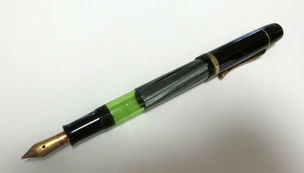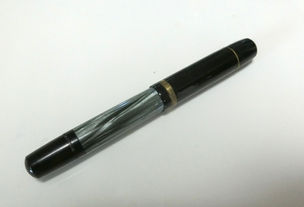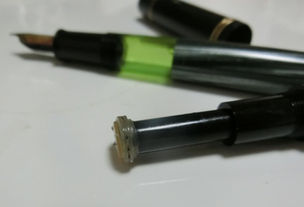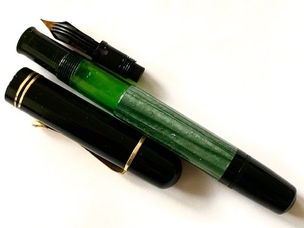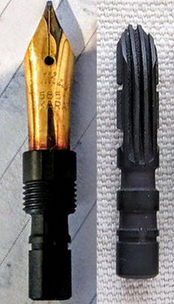top of page
Pelikan 100N (ca.1950) - the fourth generation
Green indicates the points that differ from Pelikan 101N (ca.1949).
Cap top; material: cellulose acetate, shape: conical, flat cap top edge, logo: new two chicks logo on the top and “GÜNTER WAGER Pelikan” on the lateral side.
Cap tube; material: cellulose acetate, shape: no vent holes, one gold filled fluted band⁽¹⁾, grooved around the inner wall.
Clip; gold filled fluted clip⁽¹⁾.
Nib; material: 14 carat gold, shape: round vent hole, logo:
Pelikan
585
14 KARAT
Feed; material: ebonite, shape: flat tail, four lamellae without the recess.
Nib socket; material: ebonite, shape: 13.5 mm, two notches facing each other.
Grip section and barrel; material: one piece injection molded transparent acrylics, shape; flat top edge, slightly tapered, no step near the thread, no brass ring.
Sleeve; material: cellulose acetate.
Filling system; material: injection molded acrylics with white discoid nylon seal, shape: conical, smooth turning knob.
Dimensions;
On May 25, 1950, model 400 ,the successor of model 100N, was introduced. Model 400 and 100N coexisted for 4 years (1950-1954). Günter Wagner redesigned the feed and socket for model 400. The new feed had four lamellae and more complicated ink and air channels. Interestingly, the new socket initially adopted a friction fit system, but shortly went back to a traditional screw-in fit system. Moreover, the socket was equipped with two notches to apply the special wrench, with which the socket with nib unit was removable easily and safely from the grip section. The old plier for model 100(N) could damage the nib (Fig.6), while the new tubular wrench (Fig.7) was able to unscrew the socket without applying any force to the nib. On September 18, 1950, model 600 with 14 carat gold cap and turning knob introduced. In January 1951, model 700 with fully overlaid 14 carat gold was introduced. So, in terms of both lineup and price, model 100N vacated its flagship (Pelikan catalog No.70/8 (1951)).
Getting back to model 100N, the new screw-in fit nib unit (a redesigned feed and a socket with two notches) was also introduced to model 100N on September 1, 1950 (Pelikan-collectibles)(or on January 16, 1953 (Pelikan Schreibgeräte))⁽²⁾. Just before that, a few model 100N temporarily adopted a friction fit socket (Pelikan Schreibgeräte). Fig.8, 9 show how Günter Wagner redesigned feeds and sockets for model 100N. On the new socket, 2 notches are seen where tubular wrench is applied (Fig.8, 9 arrowhead). In the early type feed of redesigned feed⁽³⁾, there are two additional "compensation chambers" on lateral sides that temporarily holds overflowed ink. Ventral compensation chambers are expanded from 2 to 3. The circumferential groove at the tail (Fig.8, 9 arrow) guides ink from the lowest part of the reservoir to the dorsal groove so as to make the last drop of ink available (@christof). As shown in Fig.8 bottom, ink/air channels consist of one central broad channel and two side grooves. Thus, the redesigned feed had technically upgraded ink channel and compensation chambers, contributing to ink availability and leak-proof.
At the same time (in 1950), disk-shaped transparent nylon seal was introduced (Fig.5) (Pelikan Schreibgeräte)⁽⁴⁾. Black elastomer seal was also used until discontinued on November 26, 1953 (Pelikan-collectibles).
In 1952, Günter Wagner discontinued model 101N, diminishing model 100N family in contrast to model 400 family.
As from April 22, 1952, CN nib was not available any more.
Note;⁽¹⁾In Pelikan catalog No.70/8 (1951), 400 series and 100N (gold nib) had gold filled ("Walzgold doublé") clip and cap ring, while 100N (CN nib) had gold-plated ("hart vergoldet") ones. It is likely that the specifications were changed after 1949 when pens with gold nib were allowed to be produced for the domestic market.
⁽²⁾According to @stoen, there exists model 100N with old feed and new socket (Fig.10), while that with new feed and old socket also does. So, it may be reasonable to assume that Günter Wagner gradually switched from old style feed/socket to new style ones.
⁽³⁾The back-end was about 2 mm shorter than that of early type 400 feed. According to @stoen, the redesigned feed of 100N and the early type feeds of model 400 and 140 were most likely machined from the same four-fin template, then the back-end would have been trimmed and fine-adjusted for them (Fig.11). According to @stoen, feeds like late type 400 feeds were found in model 100N of the late stages of production.
⁽⁴⁾The seal was also used in model 100N. According to @mana and @stoen, post-war 100N barrels and 400 barrels had identical barrel bore (internal diameter) and spiral screw gradients. So, some parts such as feeds. nibs, and seals were interchangeable between two models.
bottom of page

